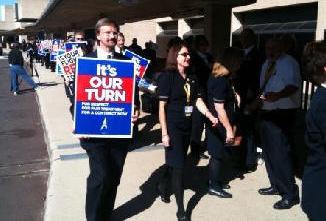|
|||||||||||
|
|
|
|||
|
By Jim Douglas |
||||
 |
May 26, 2010 - Once again, negotiations between American Airlines Flight Attendants and management ended with the same result – no contract – after three days of intensive bargaining at the National Mediation Board (NMB). Despite some progress, the Flight Attendants bargaining team leaves in frustration as the Company has yet to make a proposal that Flight Attendants would ratify. “Unfortunately after more than two years of negotiations we have reached an impasse in negotiations. This is completely unacceptable,” said Laura Glading, President of the Association of Professional Flight Attendants (APFA), representing the nearly 18,000 Flight Attendants at American. |
|||
|
|
||||
|
“From the Flight Attendants’ overwhelming
approval of strike authorization this week, it should be obvious to
the Company that 96.8 percent of Flight Attendants will not accept
an agreement that still contains unacceptable concessions.”
American Airlines Flight Attendants voted to approve a strike authorization with a record 96.8 percent voting yes and a record turnout of 90 percent. That same day at the AMR share holders meeting, American executives claimed a $600 million per year labor cost disadvantage as compared to its network competitors. Flight Attendants challenged the Company analysis as flawed, pointing out there was no documentation to support their claim filed with the Securities Exchange Commission (SEC). In a separate SEC filing the Company revealed that the top five AMR executives were awarded stock shares with an estimated value today of approximately $12.8 million. Flight Attendants are looking to achieve an agreement that significantly improves their pay, benefits and work rules after bailing out the airline in 2003 with concessions that now total more than $2.3 billion. The union asked the NMB for release from negotiations in March and plans to push for the 30-day cooling period. “Flight Attendants have been down this path before and our strike vote shows our strength and unity. We have exhausted our options at the table and now it’s time to move the process forward into the 30-day cooling period,” Glading concluded. |
||||


